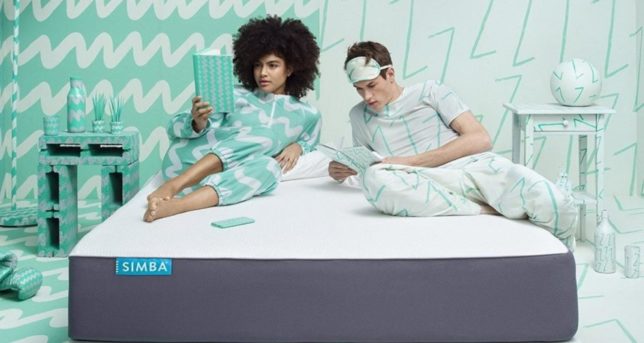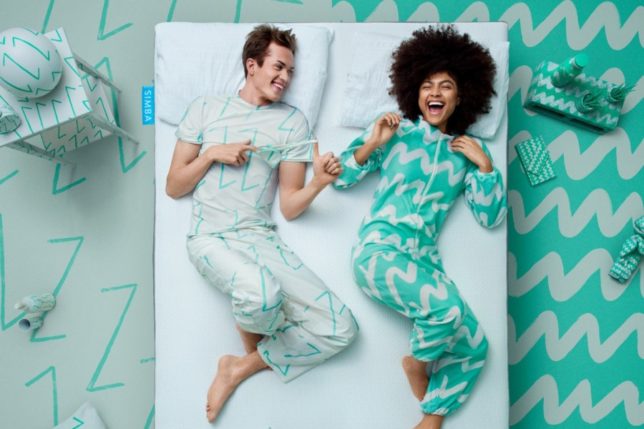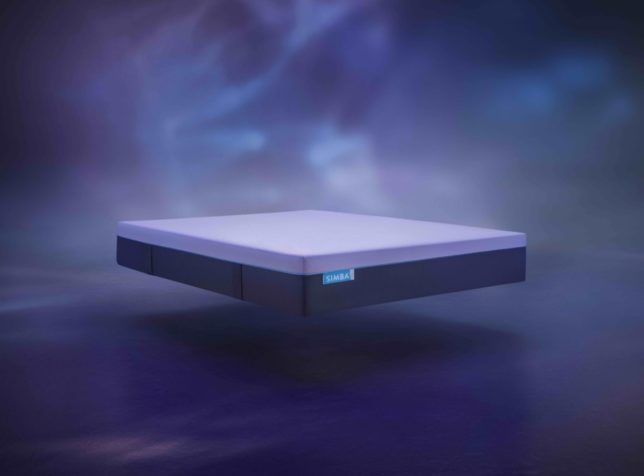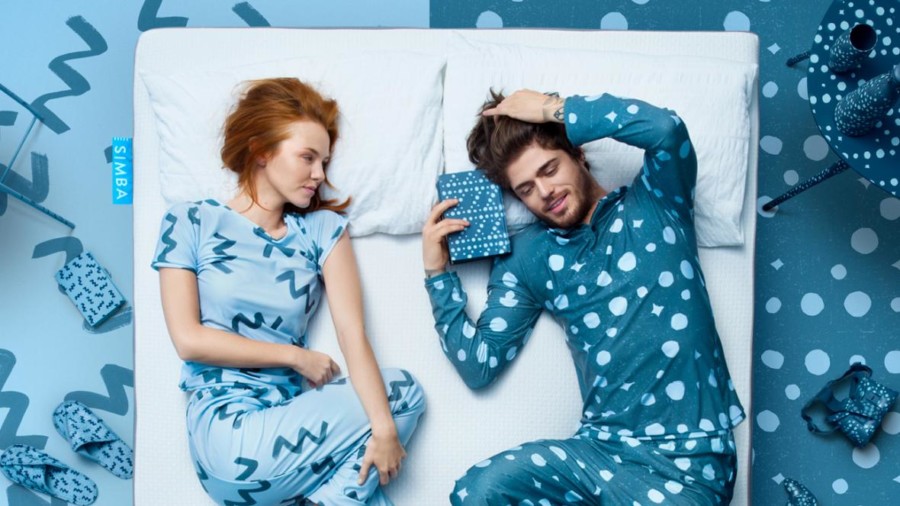By Hope Bastine (BSc (Hons), PGCE, HypDip, RYT, MBCT/MBSR Cert, MSc, PhD Researcher) – Psychologist, Mindfulness Expert & Resident Sleep Expert for sleep technology mattress firm Simba.

Here are some helpful hints on how to improve sleep patterns and overcome insomnia this winter.
A room with a sleep view
Every room in our home has a specific purpose. As we walk into it we begin associating specific activities with the space. Predictably this can change with the seasons as the number of hours of sunlight change. Therefore, it’s important to create an environment that promotes the desired activity – in this case, sleep and rest.
Bedroom décor is key to promoting a good night’s rest. Research has found that red is exciting while blue promotes competence. Another study showed that reds and yellows increased anxiety compared to blues and greens. In general, softer, muted colours like grey, pink and purples are neutral and promote tranquility.
It’s all in the head
A comfortable bed and the right supporting pillow are by far the most important items to challenge the sleep thief. The National Sleep Foundation recommends keeping your head in ‘neutral alignment’ – the way you would when standing up with good posture. Meanwhile, the quality and comfort of your bed is the secret to good slumber. A 2009 study in the Chiropractic Medical Journal found that new, medium-firm beds increased sleep quality, reduced back discomfort, and moderated stress-related symptoms that interfered with restful sleep.

Sleep don’t like it hot
The average room temperature is around 20 degrees; however, maintaining a bedroom temperature of 18 degrees or lower will mimic the body’s hibernation state and help maintain a calmer state of mind. Although it will get colder in winter, and therefore easier to regulate your room temperature, air circulation is important to stop your room getting stuffy. Having plants in the bedroom provides a good supply of oxygen – this is especially beneficial for breathing problems relating to allergies or asthma. Some well-researched suggestions include Aloe Vera; Lavender; Jasmine; Snake plant and English Ivy.
Pure PJs
The right bedding and PJs are key to managing optimum temperature and air circulation for good sleep all year round. Choose natural fabrics such as cotton, bamboo, silk or satin because they absorb excess moisture, thus regulating body temperature. Although this shouldn’t be as much of a problem in winter, it’s still important to have a comfortable sleep wardrobe and bedding. The Simba Hybrid® Duvet also follows this principle, providing ultimate comfort with a super-soft filling combined with space-inspired fabric technology designed to take the heat.

See the light
Banish the blue. Modern light sources (particularly fluorescent lights, laptops, and cellphone screens) contain a high level of blue light that disrupts melatonin production and throws off our natural circadian rhythms, keeping us awake when we should be sleeping. Many sleep specialists suggest that this widespread exposure to blue light, long after sunset, is a major contributor to the modern epidemic of insomnia – a problem exacerbated in the winter. The American Medical Association, 2012 says ‘this effect can be minimized by using dim, [warm] lighting in the night-time bedroom environment.’
Make scents of sleep
Inhaling serene scents is a great way to ensure a restful and relaxing night’s sleep during winter. Evidence suggests certain aromas may actually reduce blood pressure and heart rate, creating a calming effect in the body. Sedating scents such as lavender, jasmine around your room with either a plant or aromatherapy devices are extremely effective.
Start a sleep ritual
Research shows that simpatias (formulaic rituals), such as sleep rituals, are extremely effective in producing the desired outcome when they are repeated at a specific time and have a certain number of stages. A sleep ritual should begin 1-2 hours before bedtime but some practices need to be considered well before then. Stimulants such as caffeine stay prominent in your system for at least 6 hours (if you are sensitive, 12 hours). So plan your last cup of coffee/tea accordingly. Exercise should be completed 2 hours before you plan to go to bed. Cardio is stimulating whereas resistance training and yoga are sleep-promoting. Weight training triggers the release of growth hormone (which heals and repairs) and helps us fall into a deep sleep. Alcohol (in large quantities) is generally best avoided before bed as it disrupts the sleep cycle. Dinner should be finished at least 2 hours before bedtime. All of these routines should be adjusted with the seasons as we go through the year.

Hope’s 3-Stage Sleep Routine
1. Mind Stage (first 20 mins)
Signal it’s time to wind down by making use of the ‘bedtime’ mode on your iPhone clock. Switch off technology at least 1 hour before bedtime. No TV. No phones. No screens whatsoever. Make your sleep space sacred. The LED backlight of your devices trigger the beta brainwave state which is anxiety-inducing. Switch on an amber or pink lowlight to activate the melatonin release. Scented candles are even better. To induce the alpha brainwave state (the relaxed pre-sleep state), find activities that activate right-brain engagement. This is the creative, non-verbal side of your brain. Such activities include journal writing, playing an instrument, listening to music (classical/chill-out), reading or listening to a book (literature, fiction or poetry – nothing logical or analytical), writing poetry and writing a gratitude diary.
2. Body Stage (second 20 mins)
Consider a warm bath (not too hot as it can be anxiety-provoking) with Epsom or magnesium salts and aromatherapy oils such as lavender essence.
Massage or moisturise. Touch releases the so-called cuddle hormone oxytocin. The warm and fuzzy feeling this produces has wonderful stress releasing effect. Sex, particularly that big O, releases oxytocin in bucket loads, which is Mother Nature’s best antidote to insomnia.
Stretch it out with yoga. Boston University researchers discovered the post-yoga lull sees a remarkable 27% increase in GABA saturation after one hour that is unmatched by any medication or supplement. GABA is an amino acid that moderates mood and anxiety levels.
3. Sense Stage (last 20 mins)
Once you have created your bedroom sanctuary, consciously step over the threshold into it and connect with all the associations that make you feel calm and mentally prepared for sleep. As you slip into your bed allow your senses to wake up to feelings: smell the aroma, feel the cool crisp sheets, allow your eyes to become adjusted to the dim amber lighting, and most importantly practice the art of letting go and let your body sink into the bed.

The Simba Hybrid® Mattress from Europe’s favourite mattress-in-a-box brand has up to 2,500 25mm conical pocket titanium Aerocoil™ springs, enclosed in a 100% polyester pocket spring-comfort layer sandwiched between a reflex support layer, zoned support base and open cell Simbatex foam with edge support and graphite for cooling. So confident are Simba that you’ll get the best night’s sleep, they offer a 200-night trial and ten year guarantee. Prices start from £569. Available from simbasleep.com
This article originally appeared in the 24th Edition of SLOAN! Magazine in November 2020.
About the expert
Hope Bastine (BSc (Hons), PGCE, HypDip, RYT, MBCT/MBSR Cert, MSc, PhD Researcher) is a Psychologist, Mindfulness Expert & Resident Sleep Expert for sleep technology mattress firm Simba.

Hope trained in Neuroscience and Psychology at Westminster University before going on to teach psychology for five years with a PGCE from St Mary’s University College. Following this, she earned a Post-Graduate Diploma in Cognitive-Behavioural Hypnotherapy where she discovered how Mindfulness can cure insomnia. She began her counselling psychotherapy training with a foundation diploma from The Metanoia Institute which provided her with the opportunity to work as a CBT specialist on the IAPT service at the South London and Maudsley (SLAM) NHS for over two years before founding wellbeing company, Fresh Perception.
Hope is a Mental Health Foundation certified Mindfulness Cognitive Trainer who studied with Dr. P Collard and Jason Crandell. She has specialized in insomnia and trauma recovery research with an MSc in Applied Mental Health Research at King’s College London. She is currently researching her PhD in Human Flourishing at the University of Nottingham supervised by Prof. Stephen Joseph.

